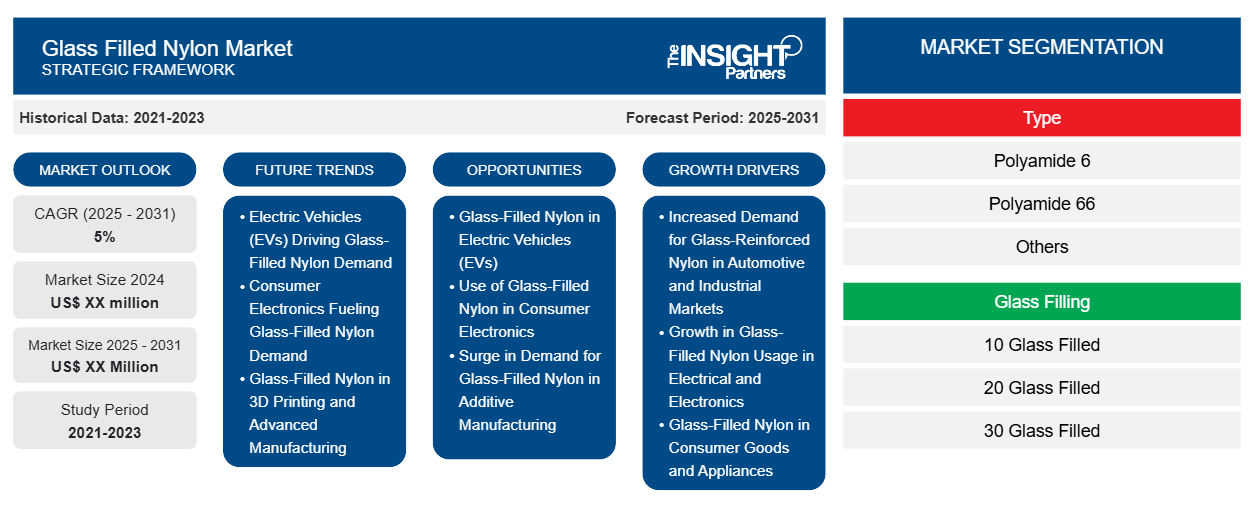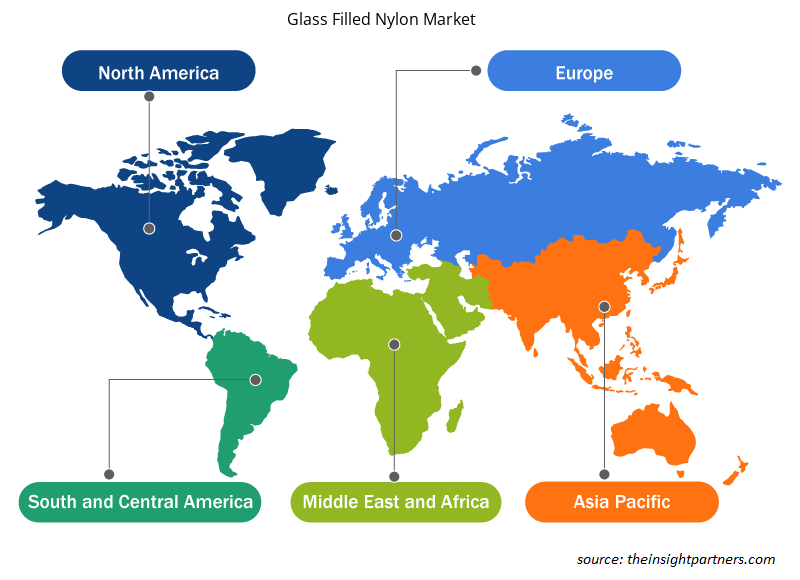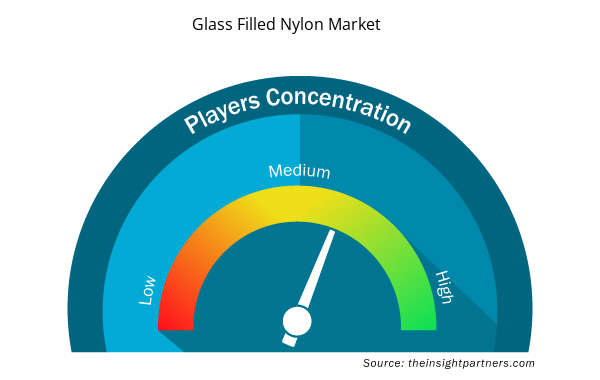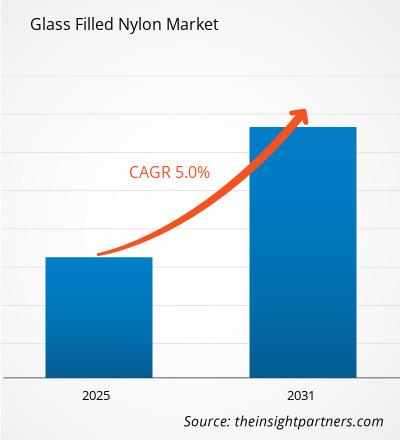Le marché du nylon chargé de verre devrait enregistrer un TCAC de 5 % de 2024 à 2031, avec une taille de marché passant de XX millions USD en 2024 à XX millions USD d'ici 2031.
Le rapport est segmenté par type (polyamide 6, polyamide 66, autres). L'analyse globale est ensuite ventilée au niveau régional et par principaux pays. Le rapport présente en outre une analyse basée sur le remplissage en verre (10 rempli de verre, 20 rempli de verre, 30 rempli de verre, 30 rempli de verre). L'analyse globale est ensuite ventilée au niveau régional et par principaux pays. La taille du marché et les prévisions aux niveaux mondial, régional et national pour tous les segments de marché clés sont couvertes dans le cadre du périmètre. Le rapport offre la valeur en USD pour l'analyse et les segments ci-dessus. Le rapport fournit des statistiques clés sur l'état du marché des principaux acteurs du marché et offre des tendances et des opportunités de marché.
Objectif du rapport
Le rapport sur le marché du nylon chargé de verre de The Insight Partners vise à décrire le paysage actuel et la croissance future, les principaux facteurs moteurs, les défis et les opportunités. Cela fournira des informations à diverses parties prenantes commerciales, telles que :
- Fournisseurs/fabricants de technologie : pour comprendre l’évolution de la dynamique du marché et connaître les opportunités de croissance potentielles, leur permettant de prendre des décisions stratégiques éclairées.
- Investisseurs : Effectuer une analyse complète des tendances concernant le taux de croissance du marché, les projections financières du marché et les opportunités qui existent tout au long de la chaîne de valeur.
- Organismes de réglementation : Réglementer les politiques et surveiller les activités du marché dans le but de minimiser les abus, de préserver la confiance des investisseurs et de maintenir l’intégrité et la stabilité du marché.
Segmentation du marché du nylon renforcé de verre
Taper
- Polyamide 6
- Polyamide 66
- Autres
Remplissage de verre
- 10 verres remplis
- 20 verres remplis
- 30 verre rempli
- 30 verre rempli
Secteur d'utilisation finale
- Automobile
- Électricité et électronique
- Industriel
- Autres
Géographie
- Amérique du Nord
- Europe
- Asie-Pacifique
- Amérique du Sud et Amérique centrale
- Moyen-Orient et Afrique
Personnalisez ce rapport en fonction de vos besoins
Vous bénéficierez d'une personnalisation gratuite de n'importe quel rapport, y compris de certaines parties de ce rapport, d'une analyse au niveau des pays, d'un pack de données Excel, ainsi que de superbes offres et réductions pour les start-ups et les universités.
Marché du nylon renforcé de fibres de verre : informations stratégiques

- Obtenez les principales tendances clés du marché de ce rapport.Cet échantillon GRATUIT comprendra une analyse de données, allant des tendances du marché aux estimations et prévisions.
Facteurs de croissance du marché du nylon renforcé de fibres de verre
- Augmentation de la demande de nylon renforcé de verre sur les marchés automobile et industriel : Le nylon renforcé de verre est de plus en plus demandé sur les marchés automobile et industriel en raison de ses propriétés mécaniques supérieures telles qu'une résistance, une rigidité et une tolérance à la chaleur plus élevées. Ces matériaux sont intégrés dans diverses parties de l'industrie automobile, à savoir le moteur, les composants utilisés pour transmettre la puissance et d'autres éléments porteurs de contraintes où l'accent est mis sur les performances et la minimisation du poids.
- Croissance de l'utilisation du nylon renforcé de verre dans les composants électriques et électroniques : La croissance rapide de la consommation de nylon renforcé de verre dans les composants électriques et électroniques reste l'un des principaux facteurs motivant le marché. Ce polymère possède une excellente isolation, combinée à une résistance à la chaleur et à la solidité, ce qui le rend parfait pour une utilisation dans des produits tels que les connecteurs, les commutateurs, les boîtiers, les circuits imprimés et autres qui doivent être fiables et durables.
- Nylon chargé de verre dans les biens de consommation et les appareils électroménagers : L'utilisation du nylon chargé de verre gagne rapidement du terrain dans les biens de consommation et les appareils électroménagers en raison de sa capacité à améliorer la qualité des produits à un coût raisonnable. Cette optimisation du poids contribue à l'amélioration des outils électriques, des appareils électroménagers et de l'électronique, car les matériaux peuvent maintenir un rapport résistance/poids élevé et contribuent ainsi à fabriquer des produits plus légers et plus résistants.
Tendances futures du marché du nylon renforcé de fibres de verre
- Les véhicules électriques (VE) stimulent la demande de nylon renforcé de verre : à mesure que les véhicules électriques se généralisent, l'industrie automobile sera témoin de l'adoption rapide du nylon renforcé de verre pour ses caractéristiques de légèreté, de haute résistance et de résistance à la chaleur. De plus en plus de composants tels que les boîtiers de batterie, les pièces du moteur et les composants structurels des véhicules électriques utiliseront du nylon renforcé de verre dans la recherche de performances et de durabilité.
- L'électronique grand public stimule la demande de nylon renforcé de verre : Le segment des appareils portables, des appareils électroniques mobiles et compacts au sein du marché de l'électronique grand public devrait stimuler la demande de nylon renforcé de verre, qui devrait augmenter au cours de la période de prévision. Les propriétés isolantes électriques étonnantes du matériau ainsi que sa résistance et sa robustesse contribuent à satisfaire le besoin de boîtiers et de connecteurs dans les appareils électroniques portables.
- Nylon chargé de verre dans l'impression 3D et la fabrication avancée : la proportion de nylon chargé de verre utilisée dans l'impression 3D devrait augmenter. Sa résistance mécanique et sa stabilité dimensionnelle ainsi que sa facilité d'application dans la fabrication additive permettent d'utiliser ce matériau pour la production de prototypes avancés et même de composants complexes. Avec le temps, à mesure que la technologie tend vers les industries remplies de verre 3D, il est prévu que le nylon chargé de verre sera utilisé plus fréquemment dans des industries telles que l'aérospatiale, l'automobile et la médecine.
Opportunités de marché pour le nylon renforcé de fibres de verre
- Nylon renforcé de verre dans les véhicules électriques (VE) : à l'avenir, à mesure que les véhicules électriques deviendront la norme, les pièces en nylon renforcé de verre deviendront de plus en plus demandées, notamment en raison des pièces dotées d'une résistance élevée, d'une résistance à la chaleur et d'une isolation. Les applications pour les véhicules électriques telles que les boîtiers de batterie, les pièces structurelles et les composants de moteurs électriques connaîtront une croissance à mesure que le monde automobile se prépare à une plus grande électrification.
- Utilisation du nylon renforcé de fibre de verre dans l'électronique grand public : avec l'expansion de l'industrie de l'électronique grand public, on peut affirmer sans risque que les composites de nylon renforcé de fibre de verre trouveront de plus en plus d'applications dans les appareils portables comme les smartphones, les ordinateurs portables, les objets connectés et autres appareils électroménagers. La robustesse, la légèreté et la capacité à fournir un support à l'intérieur de formes petites et élégantes de ces matériaux donnent lieu à la croissance des économies secondaires modernes.
- Augmentation de la demande de nylon chargé de verre dans la fabrication additive : pour la fabrication additive, ainsi que pour la fabrication d'appareils par couches, le nylon chargé de verre est devenu plus pertinent à cet effet car les tendances de fabrication de composants fonctionnels sur mesure se sont développées. Le nylon chargé de verre est de plus en plus adopté dans le prototypage rapide et la production à faible volume couvrant de nombreux secteurs comme l'automobile et la santé avec l'évolution des technologies d'impression 3D.
Aperçu régional du marché du nylon renforcé de fibres de verre
Les tendances et facteurs régionaux influençant le marché du nylon chargé de verre tout au long de la période de prévision ont été expliqués en détail par les analystes d’Insight Partners. Cette section traite également des segments et de la géographie du marché du nylon chargé de verre en Amérique du Nord, en Europe, en Asie-Pacifique, au Moyen-Orient et en Afrique, ainsi qu’en Amérique du Sud et en Amérique centrale.

- Obtenez les données régionales spécifiques au marché du nylon chargé de verre
Portée du rapport sur le marché du nylon chargé de verre
| Attribut de rapport | Détails |
|---|---|
| Taille du marché en 2024 | XX millions de dollars américains |
| Taille du marché d'ici 2031 | XX millions de dollars américains |
| Taux de croissance annuel composé mondial (2025-2031) | 5% |
| Données historiques | 2021-2023 |
| Période de prévision | 2025-2031 |
| Segments couverts | Par type
|
| Régions et pays couverts | Amérique du Nord
|
| Leaders du marché et profils d'entreprises clés |
|
Acteurs du marché du nylon renforcé de fibres de verre Densité : comprendre son impact sur la dynamique commerciale
Le marché du nylon renforcé de verre connaît une croissance rapide, tirée par la demande croissante des utilisateurs finaux en raison de facteurs tels que l'évolution des préférences des consommateurs, les avancées technologiques et une plus grande sensibilisation aux avantages du produit. À mesure que la demande augmente, les entreprises élargissent leurs offres, innovent pour répondre aux besoins des consommateurs et capitalisent sur les tendances émergentes, ce qui alimente davantage la croissance du marché.
La densité des acteurs du marché fait référence à la répartition des entreprises ou des sociétés opérant sur un marché ou un secteur particulier. Elle indique le nombre de concurrents (acteurs du marché) présents sur un marché donné par rapport à sa taille ou à sa valeur marchande totale.
Les principales entreprises opérant sur le marché du nylon chargé de verre sont :
- Groupe Arkema
- Société Asahi Kasei
- BASF SE
- EI du Pont de Nemours et Compagnie
- EMS-CHEMIE HOLDING AG
Avis de non-responsabilité : les sociétés répertoriées ci-dessus ne sont pas classées dans un ordre particulier.

- Obtenez un aperçu des principaux acteurs du marché du nylon chargé de verre
Principaux arguments de vente
- Couverture complète : Le rapport couvre de manière exhaustive l’analyse des produits, des services, des types et des utilisateurs finaux du marché du nylon rempli de verre, offrant un paysage holistique.
- Analyse d’experts : Le rapport est compilé sur la base d’une compréhension approfondie des experts et analystes du secteur.
- Informations à jour : Le rapport garantit la pertinence commerciale en raison de sa couverture des informations récentes et des tendances des données.
- Options de personnalisation : ce rapport peut être personnalisé pour répondre aux exigences spécifiques du client et s'adapter parfaitement aux stratégies commerciales.
Le rapport de recherche sur le marché du nylon chargé de verre peut donc aider à ouvrir la voie au décodage et à la compréhension du scénario de l’industrie et des perspectives de croissance. Bien qu’il puisse y avoir quelques préoccupations valables, les avantages globaux de ce rapport ont tendance à l’emporter sur les inconvénients.
- Analyse historique (2 ans), année de base, prévision (7 ans) avec TCAC
- Analyse PEST et SWO
- Taille du marché Valeur / Volume - Mondial, Régional, Pays
- Industrie et paysage concurrentiel
- Ensemble de données Excel



Report Coverage
Revenue forecast, Company Analysis, Industry landscape, Growth factors, and Trends

Segment Covered
This text is related
to segments covered.

Regional Scope
North America, Europe, Asia Pacific, Middle East & Africa, South & Central America

Country Scope
This text is related
to country scope.
Questions fréquemment posées
Increase in demand from electric vehicles (EVs) is expected to be the key market trends
Based on type, the polyamide 66 segment is expected to witness the fastest growth during the forecast period
Based on geography, Asia Pacific held the largest share of the glass filled nylon market due to the well-established automotive industry across the region, coupled with continuous growth and development
Rising demand for high-performance materials in automotive and industrial applications is driving the market growth
DuPont de Nemours, Inc.
; BASF SE
; Solvay
; LANXESS AG
; DSM Engineering Materials
; Toray Industries, Inc.
; Ascend Performance Materials
; Clariant International Ltd.
; Evonik Industries AG
; PolyOne Corporation
; SABIC
; 3M Company
; Mitsui Chemicals, Inc.
; Kraton Polymers
; Huntsman Corporation
The Glass Filled Nylon Market is estimated to witness a CAGR of 5% from 2023 to 2031
Trends and growth analysis reports related to Chemicals and Materials : READ MORE..
1.Arkema Group
2.Asahi Kasei Corporation
3.BASF SE
4.E. I. du Pont de Nemours and Company
5.EMS-CHEMIE HOLDING AG
6.Evonik Industries
7.Lanxess
8.Royal DSM N.V.
9.RTP Company
10.SABIC
The Insight Partners performs research in 4 major stages: Data Collection & Secondary Research, Primary Research, Data Analysis and Data Triangulation & Final Review.
- Data Collection and Secondary Research:
As a market research and consulting firm operating from a decade, we have published and advised several client across the globe. First step for any study will start with an assessment of currently available data and insights from existing reports. Further, historical and current market information is collected from Investor Presentations, Annual Reports, SEC Filings, etc., and other information related to company’s performance and market positioning are gathered from Paid Databases (Factiva, Hoovers, and Reuters) and various other publications available in public domain.
Several associations trade associates, technical forums, institutes, societies and organization are accessed to gain technical as well as market related insights through their publications such as research papers, blogs and press releases related to the studies are referred to get cues about the market. Further, white papers, journals, magazines, and other news articles published in last 3 years are scrutinized and analyzed to understand the current market trends.
- Primary Research:
The primarily interview analysis comprise of data obtained from industry participants interview and answers to survey questions gathered by in-house primary team.
For primary research, interviews are conducted with industry experts/CEOs/Marketing Managers/VPs/Subject Matter Experts from both demand and supply side to get a 360-degree view of the market. The primary team conducts several interviews based on the complexity of the markets to understand the various market trends and dynamics which makes research more credible and precise.
A typical research interview fulfils the following functions:
- Provides first-hand information on the market size, market trends, growth trends, competitive landscape, and outlook
- Validates and strengthens in-house secondary research findings
- Develops the analysis team’s expertise and market understanding
Primary research involves email interactions and telephone interviews for each market, category, segment, and sub-segment across geographies. The participants who typically take part in such a process include, but are not limited to:
- Industry participants: VPs, business development managers, market intelligence managers and national sales managers
- Outside experts: Valuation experts, research analysts and key opinion leaders specializing in the electronics and semiconductor industry.
Below is the breakup of our primary respondents by company, designation, and region:

Once we receive the confirmation from primary research sources or primary respondents, we finalize the base year market estimation and forecast the data as per the macroeconomic and microeconomic factors assessed during data collection.
- Data Analysis:
Once data is validated through both secondary as well as primary respondents, we finalize the market estimations by hypothesis formulation and factor analysis at regional and country level.
- Macro-Economic Factor Analysis:
We analyse macroeconomic indicators such the gross domestic product (GDP), increase in the demand for goods and services across industries, technological advancement, regional economic growth, governmental policies, the influence of COVID-19, PEST analysis, and other aspects. This analysis aids in setting benchmarks for various nations/regions and approximating market splits. Additionally, the general trend of the aforementioned components aid in determining the market's development possibilities.
- Country Level Data:
Various factors that are especially aligned to the country are taken into account to determine the market size for a certain area and country, including the presence of vendors, such as headquarters and offices, the country's GDP, demand patterns, and industry growth. To comprehend the market dynamics for the nation, a number of growth variables, inhibitors, application areas, and current market trends are researched. The aforementioned elements aid in determining the country's overall market's growth potential.
- Company Profile:
The “Table of Contents” is formulated by listing and analyzing more than 25 - 30 companies operating in the market ecosystem across geographies. However, we profile only 10 companies as a standard practice in our syndicate reports. These 10 companies comprise leading, emerging, and regional players. Nonetheless, our analysis is not restricted to the 10 listed companies, we also analyze other companies present in the market to develop a holistic view and understand the prevailing trends. The “Company Profiles” section in the report covers key facts, business description, products & services, financial information, SWOT analysis, and key developments. The financial information presented is extracted from the annual reports and official documents of the publicly listed companies. Upon collecting the information for the sections of respective companies, we verify them via various primary sources and then compile the data in respective company profiles. The company level information helps us in deriving the base number as well as in forecasting the market size.
- Developing Base Number:
Aggregation of sales statistics (2020-2022) and macro-economic factor, and other secondary and primary research insights are utilized to arrive at base number and related market shares for 2022. The data gaps are identified in this step and relevant market data is analyzed, collected from paid primary interviews or databases. On finalizing the base year market size, forecasts are developed on the basis of macro-economic, industry and market growth factors and company level analysis.
- Data Triangulation and Final Review:
The market findings and base year market size calculations are validated from supply as well as demand side. Demand side validations are based on macro-economic factor analysis and benchmarks for respective regions and countries. In case of supply side validations, revenues of major companies are estimated (in case not available) based on industry benchmark, approximate number of employees, product portfolio, and primary interviews revenues are gathered. Further revenue from target product/service segment is assessed to avoid overshooting of market statistics. In case of heavy deviations between supply and demand side values, all thes steps are repeated to achieve synchronization.
We follow an iterative model, wherein we share our research findings with Subject Matter Experts (SME’s) and Key Opinion Leaders (KOLs) until consensus view of the market is not formulated – this model negates any drastic deviation in the opinions of experts. Only validated and universally acceptable research findings are quoted in our reports.
We have important check points that we use to validate our research findings – which we call – data triangulation, where we validate the information, we generate from secondary sources with primary interviews and then we re-validate with our internal data bases and Subject matter experts. This comprehensive model enables us to deliver high quality, reliable data in shortest possible time.

 Obtenez un échantillon gratuit pour ce rapport
Obtenez un échantillon gratuit pour ce rapport